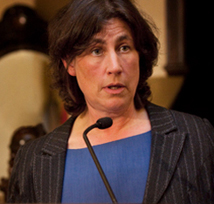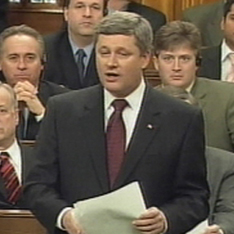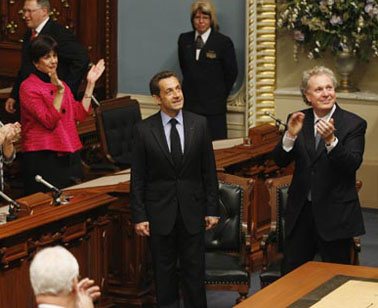Why even Bert Brown’s new “Triple E” Senate reform plan for Canada still won’t work ..
Nov 4th, 2011 | By Randall White | Category: Canadian Provinces
Senate reform in another time and place, far away and long ago. Ottawa has not quite stooped this low ... YET.
It says a lot about the ongoing problems of Senate reform in Canada that the main source for news on the latest wrinkle in Bert Brown’s “Triple E” Senate concept is the Edmonton Journal.
(And what we’re talking about here, I should make clear, is not PM Harper’s two “step by step” and non-constitutional reform measures – on term limits and provincial Senate elections. There seems little doubt that these will be passed in due course by the current Conservative majority in Parliament. Bert Brown’s new proposal is about future steps in the reform process, beyond Mr. Harper’s present real-world-of-politics agenda.)
As a long-time enthusiast for a version of Senate reform that actually fits Canada’s somewhat unique national circumstances, I would second University of Calgary political scientist Tom Flanagan’s recent view of Mr. Brown’s new Triple E proposal. Prof. Flanagan has “said there’s little likelihood Ottawa and the provinces will agree to a constitutional amendment on Senate reform, but … Brown’s idea is an interesting ‘novelty’ that departs from the original Triple E model … ‘It’s certainly symbolic when the original proponent is willing to come out for something different,’ Flanagan said.”

“Canada’s only elected Senator” Bert Brown, at a press conference this past June. Stuart Dryden/QMI AGENCY.
At the same time, I also think that even if Ottawa and the provinces were in the mood for some kind of constitutional amendment on Senate reform, even Mr. Brown’s new “something different” from the original Triple E model would not finally qualify for a passing grade. The decisive explanation here is nicely laid out in Chantal Hébert’s latest column in the Toronto Star – which has nothing to do with Senate reform directly.
In a piece entitled “Political culture transformed since Constitution repatriated,” Ms. Hébert summarizes a new Canadian federal reality that Mr. Brown (along with many others still among us, certainly) has not yet quite digested, or accepted, or understood – or perhaps even just taken the time and trouble to read the latest memo on.
As Chantal Hébert puts it, back 30 “years ago this month,” when “ nine premiers and the prime minister of the day” came to the agreement that resulted in the new Constitution Act 1982, some “premiers naturally wondered whether the decision to dispense from Quebec’s formal support would give a boost to its secessionist aspirations … But none envisaged that the next three decades would see the gradual instauration of a federalist version of the sovereignty-association concept Trudeau had fought against on behalf of Canada in the 1980 Quebec referendum … In today’s Parliament, the three main parties have all, to varying degree, espoused asymmetrical federalism as a legitimate formula to deal with Quebec.”
Mr. Brown’s new “7—50” Senate override formula

Prime Minister Stephen Harper arrives with newly-appointed Conservative Senator Bert Brown for his Oath of Allegiance on Parliament Hill on Oct. 16, 2007. TOM HANSON/THE CANADIAN PRESS.
Peter O’Neil has described perennial Senate reformer Bert Brown’s new proposal succinctly enough, in the November 2 online edition of the Edmonton Journal:
“Brown, 73, ran in all three Senate elections in Alberta and came first, with more than 300,000 votes, in the 2004 vote. He was appointed by Harper in 2007 to fill the vacancy left by the retirement of Liberal Dan Hays.
“Brown, who says he speaks frequently with Harper on Senate reform issues, was distributing a two-page policy briefing note on Parliament Hill on Wednesday that sets out a path to full Senate reform.
“It begins by expressing his hope that provinces will agree to endorse Harper’s legislation now before Parliament that would set senators’ term limits at nine years, and would allow provinces to hold Senate elections.
“The next step, he said, would be for a round of federal-provincial constitutional talks dedicated only to the Senate issue.
“Brown said in his brief that it is the ‘government’s vision’ that a future constitutional amendment to create an equal Senate would ensure the House of Commons is ‘supreme’ by only allowing bills to be defeated through a special majority.

Canadian Senator Linda Frum and her brother, David – would she have made it if you had to be elected to get into the chamber of sober second thought?
“So while all provinces would have the same number of seats – ending a historic imbalance in which Atlantic Canada now has 30 of 105 seats despite having just seven per cent of Canada’s population – a simple majority would no longer be enough for the Senate to kill a bill sent up from the House of Commons.
“‘The Senate could veto a bill only with the support of a majority of senators from each of seven out of 10 provinces representing 50 per cent of the population,’ Brown wrote in his proposal.
“The so-called 7—50 idea comes from the constitutional amending formula in the 1982 Constitution Act, which was intended to allow reforms on certain issues only if one of Ontario or Quebec plus at least six other provinces backed the change …
“Brown’s decades-long campaign still faces numerous hurdles. The Quebec government said it views Harper’s modest changes in the bill now before Parliament as unconstitutional, and plans to fight the bill in court.”
Even mere symbolic “provincial equality” in a reformed Senate won’t cut mustard in Quebec

Chantal Hébert gives a passionate lecture at the McGill Institute for the Study of Canada., January 2010. CLAUDIO CALLIGARIS.
As already alluded to, you don’t have to be a rocket scientist to figure out that even Mr. Brown’s new 7—50 override version of Triple E Senate reform will still not fly in Quebec. All you have to do is read Chantal Hébert’s column in the November 2, 2011 Toronto Star.
Again, as Ms. Hébert explains, one of the great ironies of Canadian political history over the past 30 years has been that it has gradually stumbled into “a federalist version of the sovereignty-association concept Trudeau had fought against on behalf of Canada in the 1980 Quebec referendum … In today’s Parliament, the three main parties have all, to varying degree, espoused asymmetrical federalism as a legitimate formula to deal with Quebec.”
If you want some hard evidence on this point, consider the November 27, 2006 motion passed by the Canadian House of Commons, 266 to 16, which read: “That this House recognize that the Québécois form a nation within a united Canada.”

Stephen Harper surprises Canadian House of Commons by announcing that his party wants to recognize Quebecois as a nation within a united Canada, November 22, 2006. Five days later the Commons voted overwhelmingly in favour of a motion to this effect.
It is true enough that Prime Minister Harper said at the time that “he is using the word nation in a ‘cultural-sociological’ rather than in a legal sense.” But after the vote he also said: “I think tonight was an historic night … Canadians across the country said ‘yes’ to Quebec, ‘yes’ to Quebecers, and Quebecers said ‘yes’ to Canada … In politics you take risks – that’s what we did – but national unity, national reconciliation are more important than any one party or than any one individual.”
However you look at all this, the November 27, 2006 resolution does clearly enough imply that, whatever else, Quebec is “not a province like the others.” (Wouldn’t, eg, a resolution of the federal Parliament that “Albertans form a nation within a united Canada.” imply that Alberta was not province like the others, even if “nation” was being used in a “‘cultural-sociological’ rather than in a legal sense”? And then Quebec also has – and has had since the 19th century and in various respects even before – a civil law tradition and a majority language different from any other province!)
The big trouble with even Mr. Brown’s new 7—50 override version of Triple E Senate reform in this context is that it still tries to pretend Quebec actually is “a province like the others,” and, symbolically, all provinces of Canada are the same, and thus have the same representation in a reformed Senate. The new formula does, as Peter O’Neil in the Edmonton Journal explains, “hand effective veto power during votes on legislation to senators from Ontario and Quebec” by ensuring that a reformed Senate could override House of Commons legislation “only if one of Ontario or Quebec plus at least six other provinces backed the change” (italics added). But that isn’t the fundamental problem.

French President Nicolas Sarkozy, centre, is applauded by Quebec Premier Jean Charest, right, and members of Quebec's National Assembly, Friday, October 17, 2008. Jacques Boissinot/Canadian Press.
As an Ontario resident, my guess is also that any Ontario provincial government – and certainly the one we have now – will finally agree with Quebec on this issue. Amending the present Constitution of Canada to implement even Mr. Brown’s new 7—50 override version of Triple E Senate reform, with the support of Ontario and six other provinces outside Quebec, but without the support of Quebec, would simply be a recipe for the destruction of Canada. Or, Quebec will just never agree with any version of equal provincial representation, for its own good enough reasons. And for the moment Ontario, because it is right next door to Quebec, and has a long history (and many, many economic connections) with what the increasingly legendary old Progressive Conservative Premier William Grenville Davis used to call “our sister province” of Quebec, has a perhaps somewhat finer sense of just how serious this prospect is than most other provinces.
 It is no doubt equally true that, at the moment, Bert Brown and many others, in all parts of the country (including Ontario and perhaps even a few parts of Westmount in Quebec?), are still not prepared to use the actual allocation of seats in a reformed federal Senate of Canada to both bring greater regional representation to federal institutions in Ottawa, and recognize that, in practice as well as theory, the Québécois do form a nation within a united Canada. It still does seem to me, however, that until we have some new broad consensus on this kind of change in provincial representation, the goal of “full Senate reform” will continue to elude us. Bert Brown without a doubt deserves a lot of credit for his exertions here. But this IS a very tough issue. And Mr. Brown and the rest of us outside Quebec still have a few more miles to go before we rest.
It is no doubt equally true that, at the moment, Bert Brown and many others, in all parts of the country (including Ontario and perhaps even a few parts of Westmount in Quebec?), are still not prepared to use the actual allocation of seats in a reformed federal Senate of Canada to both bring greater regional representation to federal institutions in Ottawa, and recognize that, in practice as well as theory, the Québécois do form a nation within a united Canada. It still does seem to me, however, that until we have some new broad consensus on this kind of change in provincial representation, the goal of “full Senate reform” will continue to elude us. Bert Brown without a doubt deserves a lot of credit for his exertions here. But this IS a very tough issue. And Mr. Brown and the rest of us outside Quebec still have a few more miles to go before we rest.



My problem with Bert Brown’s 7-50 override Senate proposal is that one could translate that as a 4 provinces or representing 50 percent of the population. Imagine nine seats for each province with senators being elected by the First Past the Post system. If one party could win 5 seats in the four smalles provinces with 40 percent of the vote in the winning ridings, that means that means that 20/90 Senators who represent 1.53 percent of Canadian voters who come from the Atlantic provinces could approve a bill passed by the House of Commons. It also means that 10/90 Senators representing Ontario (5/9) and Quebec (5/9) could also effectively pass a bill that has be approved by the House of Commons. The territorial Senators will be meaningless.
What does the high override threshold mean to Senate elections. Voters will know that Senate elections will have no effect on an ineffective Senate. A governing party in the House of Commons will only need to campaign to get a majority of the seats within Ontario and Quebec, or get a majority of the seats in any four provinces. Voters will realize that the Senate will become ineffective; citizens will end up not voting.
I originally found the points Mr. Dipper is making here a little hard to grasp — perhaps as a result of my advancing age, or drinking too much hard water the night before. A post by Peter Wrightwater on his Paper Dynamite Online site has made the argument clearer to me.
As Mr. Wrightwater explains, Bert Brown’s new 7-50 proposal “would make the Senate less EQUAL only insofar as Ontario and Quebec senators acting together (NOT SEPARATELY) could prevent the senators from the remaining eight provinces from STOPPING legislation … Similarly, the senators from any four provinces acting together could prevent the senators from the remaining six provinces from STOPPING legislation.”
Mr. Dipper, I think I now see, is making essentially the same argument. And it’s no doubt well taken. (Although for still somewhat more clarity “from STOPPING legislation originating in the House of Commons” should probably be specified. The argument does not apply to legislation originating in the Senate itself — to which Mr. Brown’s 7-50 formula would not apply either. The extent to which these abstract possibilities regarding the combination of majorities of Senators from various provinces would be likely to happen in practice, in the real world of politics, is also something to wonder about, I think.)
Mr. Wrightwater urges as well (aptly enough, it seems to me) that “there is no Central Canada favouritism story here. The 7-50 rule was originally called the Alberta-Vancouver formula, after all.” See his piece “New Senate Reform Proposal Does NOT Give Ontario And Quebec An Effective Veto” at http://pdo2.blogspot.com/2011/11/new-senate-reform-proposal-does-not.html . It still similarly seems to me that the crucial defect of Mr. Brown’s new plan is its failure to deal with, or even recognize, what Ms. Hébert calls the “federalist version of the sovereignty-association concept Trudeau had fought against on behalf of Canada in the 1980 Quebec referendum” — which is now the essential glue that continues to keep Quebec in Canada. (And this could be dealt with through a kind of Senate reform that reassessed the late 20th absolutist ideology of century provincial equality, while still treating the Senate as an agency of enhanced regional representation for less populous provinces.)